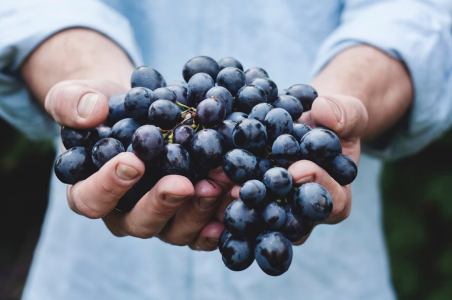What 12 grapes at midnight have to do with good luck and new beginnings
- Replies 0
There’s something deeply comforting about the small rituals we cling to when one year slips into the next.
Whether it’s the quiet countdown with friends, the clink of glasses at midnight, or the whispered wishes for what’s ahead, every tradition carries a bit of magic and hope.
But for millions around the world, that magic comes in the form of something surprisingly simple—twelve green grapes.
One for each stroke of midnight, one for each month to come, each bite carrying a promise of luck, love, and renewal. And while it may sound whimsical, this sweet superstition has roots that stretch back more than a century.
Originating in Spain, the tradition of eating twelve grapes at midnight is known as “Las doce uvas de la suerte”—“The twelve grapes of luck.”
Each grape represents one month of the year ahead, and finishing all twelve before the clock strikes twelve-thirty is said to ensure prosperity and good fortune.
The custom began in the late 1800s but gained national popularity in the early 1900s when grape farmers in Alicante had an unusually large harvest and encouraged the practice to boost sales.
Over time, what began as a clever marketing tactic transformed into a beloved New Year’s Eve ritual that spread far beyond Spain’s borders.

In practice, the ritual is as joyous as it is chaotic: eat one grape with each chime of the clock at midnight. It sounds simple enough, but many quickly realize twelve grapes in twelve seconds is no easy feat.
Some make it easier by skewering the grapes, peeling them, or choosing seedless varieties. In Spain, special tins of “lucky grapes” are even sold pre-peeled and ready to go for the celebration.
Whether eaten at home with family or in massive public gatherings like Puerta del Sol in Madrid or even Times Square in New York, the act symbolizes more than just fun—it’s about welcoming the new year with intention and gratitude.
Beyond good fortune, each grape is believed to hold power over different aspects of life. Some eat them while silently wishing for health, others for love, wealth, or simply peace of mind.
Also read: October's best fast-food deals will stretch your budget further than ever
Traditionally, Aledo grapes, a pale and delicate variety grown in Spain and protected by designation of origin, are considered the luckiest to use.
And while online videos might try to convince you to eat them under a table for better luck, that part’s just a modern twist—not history.
What truly matters is the mindfulness behind the moment—your hopes, your laughter, and your willingness to believe in small, symbolic beginnings.
For writer Annie Campbell, the realization came a little late. As she stirred collard greens and black-eyed peas for her traditional Southern New Year’s feast, her social feed filled with people downing grapes at midnight.
Also read: A Michelin-star secret now sits on Trader Joe’s shelves
The simple gesture caught her curiosity—and by next New Year’s Eve, she vowed she’d be ready.
Whether or not you believe in luck, there’s something undeniably lovely about gathering with loved ones, counting down together, and sharing in a ritual that transcends cultures and generations.
Read next:

So as the countdown begins this New Year’s Eve, why not try it yourself? Gather twelve grapes, make twelve wishes, and welcome the next chapter with a smile. Have you ever taken part in this tradition—or do you have your own lucky ritual to ring in the year? Share your thoughts and New Year’s superstitions below!
Whether it’s the quiet countdown with friends, the clink of glasses at midnight, or the whispered wishes for what’s ahead, every tradition carries a bit of magic and hope.
But for millions around the world, that magic comes in the form of something surprisingly simple—twelve green grapes.
One for each stroke of midnight, one for each month to come, each bite carrying a promise of luck, love, and renewal. And while it may sound whimsical, this sweet superstition has roots that stretch back more than a century.
Originating in Spain, the tradition of eating twelve grapes at midnight is known as “Las doce uvas de la suerte”—“The twelve grapes of luck.”
Each grape represents one month of the year ahead, and finishing all twelve before the clock strikes twelve-thirty is said to ensure prosperity and good fortune.
The custom began in the late 1800s but gained national popularity in the early 1900s when grape farmers in Alicante had an unusually large harvest and encouraged the practice to boost sales.
Over time, what began as a clever marketing tactic transformed into a beloved New Year’s Eve ritual that spread far beyond Spain’s borders.

What 12 grapes at midnight have to do with good luck and new beginnings. Image source: Maja Petric / Unsplash
In practice, the ritual is as joyous as it is chaotic: eat one grape with each chime of the clock at midnight. It sounds simple enough, but many quickly realize twelve grapes in twelve seconds is no easy feat.
Some make it easier by skewering the grapes, peeling them, or choosing seedless varieties. In Spain, special tins of “lucky grapes” are even sold pre-peeled and ready to go for the celebration.
Whether eaten at home with family or in massive public gatherings like Puerta del Sol in Madrid or even Times Square in New York, the act symbolizes more than just fun—it’s about welcoming the new year with intention and gratitude.
Beyond good fortune, each grape is believed to hold power over different aspects of life. Some eat them while silently wishing for health, others for love, wealth, or simply peace of mind.
Also read: October's best fast-food deals will stretch your budget further than ever
Traditionally, Aledo grapes, a pale and delicate variety grown in Spain and protected by designation of origin, are considered the luckiest to use.
And while online videos might try to convince you to eat them under a table for better luck, that part’s just a modern twist—not history.
What truly matters is the mindfulness behind the moment—your hopes, your laughter, and your willingness to believe in small, symbolic beginnings.
For writer Annie Campbell, the realization came a little late. As she stirred collard greens and black-eyed peas for her traditional Southern New Year’s feast, her social feed filled with people downing grapes at midnight.
Also read: A Michelin-star secret now sits on Trader Joe’s shelves
The simple gesture caught her curiosity—and by next New Year’s Eve, she vowed she’d be ready.
Whether or not you believe in luck, there’s something undeniably lovely about gathering with loved ones, counting down together, and sharing in a ritual that transcends cultures and generations.
Read next:
- 9 Delicious New Year’s foods that promise luck and prosperity
- Would you change your name for nearly 2 decades of free beer? Busch Light’s wild new offer has fans buzzing!
Key Takeaways
- The Spanish New Year’s tradition “Las doce uvas de la suerte” dates back to the early 1900s and symbolizes luck for each month of the coming year.
- The ritual spread worldwide, with variations including peeled grapes, skewered servings, and regional interpretations on how to eat them.
- While rooted in superstition, the act of eating 12 grapes is also a celebration of hope, gratitude, and fresh beginnings shared with loved ones.
- More than a custom, it’s a reminder that small, joyful acts—even something as simple as eating grapes—can carry big meaning when done with intention.






